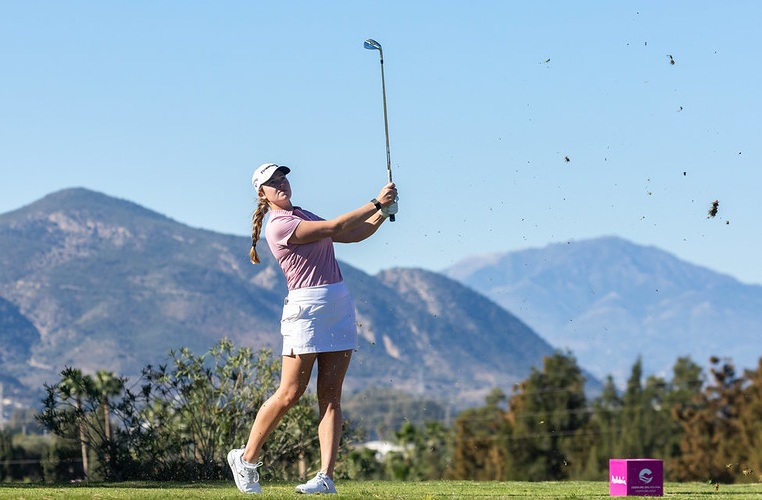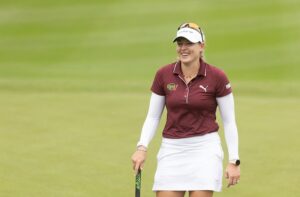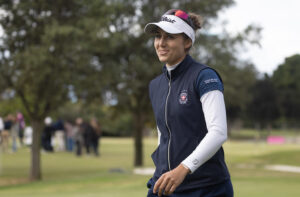International Golf Federation officials confirmed today the qualification system that will be used for golf in the 2016 Olympic Games in Rio de Janeiro. The announcement was made during a press conference at Royal Liverpool Golf Club, site of this week’s Open Championship, and follows ratification of the system by the Executive Board of the International Olympic Committee (IOC).
As outlined by IGF President Peter Dawson, Vice President Ty Votaw and Executive Director Antony Scanlon, the following will apply:
In both the women’s and men’s events a field of 60 players will compete in a 72-hole stroke play format competition for the Gold, Silver and Bronze medals. The 60 positions available in each event will be allocated through an Olympic Golf Ranking (OGR) list published on the IGF website, based on the player’s respective official world golf ranking as follows:
- Players within the top-15 on the respective women’s and men’s official world golf rankings as of 11 July 2016 will be eligible, except that there will be no more than four players from any one country eligible within the top-15.
- The balance of the field will be selected in order from 16th place onwards on the respective women’s and men’s official world golf rankings as of as of 11 July 2016, up to a maximum of 2 players per country for those countries not already having more than 2 players within the top-15.
A provision has been included for the host country, Brazil, which will guarantee that at least one Brazilian female and male golfer will compete in the Games if not otherwise eligible, based on position within the respective official world golf rankings. Another provision has also been included that each of the five continents of the Olympic Movement (Africa, Americas, Asia, Europe and Oceania) will be guaranteed at least one athlete in each of the men’s and women’s events, if not otherwise eligible, based on position within the respective official world golf rankings. These provisions will not increase the field size beyond 60 athletes in each of the women’s and men’s competitions.
The two-year qualification period for the Olympic Golf Ranking will run from 14 July 2014 to 11 July 2016. Throughout that time, an OGR list will be published each week using the current women’s and men’s official world golf rankings at internationalgolffederation.org (showing the mock field for the event as if played that week using the rankings system). The IGF will publish the final OGR list as of 11 July 2016 following the conclusion of all eligible events.
“This is an important milestone on the road to golf’s return to the Olympic Games in 2016,” Dawson said. “We are pleased to confirm the eligibility criteria and to give the athletes, National Olympic Committees and National Federations clarity on the qualification process. The world’s best players now know what they must achieve to be part of golf’s historic return to the Games in Rio de Janeiro.”
For more information visit internationalgolffederation.org
About The Olympic Golf Rankings (OGR):
The Olympic Golf Rankings List is the list of 60 players eligible for the women’s and men’s Olympic Golf Competitions as published at internationalgolffederation.org. Each OGR List is calculated using the approved eligibility criteria outlined above according to the rankings on the Men’s Official World Golf Ranking (OWGR – www.owgr.com) and the Rolex Women’s World Golf Rankings (www.rolexrankings.com). The 60 positions in each event as listed on the OGR are allocated according to athlete name, as per IOC rules.
The men’s Official World Golf Ranking (OWGR) recognises official prize money events on the following tours: PGA TOUR, European Tour, PGA Tour of Australasia, Japan Golf Tour, Southern Africa Sunshine Tour, Asian Tour, Web.com Tour, European Challenge Tour, Korean Golf Tour, PGA Tour Canada, PGA TOUR Latinoamérica and PGA TOUR China.
The Rolex Women’s World Golf Rankings recognises official prize money events on the following Tours: Ladies Professional Golf Association (LPGA), Ladies European Tour (LET), Ladies Professional Golfers’ Association of Japan (JLPGA), Korea Ladies Professional Golf Association (KLPGA), Australian Ladies Professional Golf (ALPG), Symetra Tour, China Ladies Professional Golf Association Tour (CLPGA) and the Ladies European Tour Access Series (LETAS). It also recognises the Ladies’ Golf Union, which administers the Ricoh Women’s British Open, and the United States Golf Association (USGA), which conducts the U.S. Women’s Open.
For more information on the OGR contact the International Golf Federation.
About the International Golf Federation:
The IGF was founded in 1958 to encourage the international development of the game and to employ golf as a vehicle to foster friendship and sportsmanship. Recognised by the International Olympic Committee as the official international federation for golf, the IGF is comprised of 123 Federations from 118 countries.
The IGF created the IGF Olympic Golf Committee to drive its effort for the sport’s inclusion in the 2016 Games. Organisations represented on the committee are The R&A; European Tour; USGA; PGA of America; PGA TOUR; LPGA; the Masters Tournament; The Asian Tour; Australian Ladies Professional Golf Tour; Canadian Professional Golf Tour; Japan Golf Tour Organisation; The Ladies Professional Golfers Association of Japan; Korea Ladies Professional Golf Association; Korean Professional Golf Association; Ladies European Tour; Ladies Asian Golf Tour Ltd; PGA Tour of Australasia and The Sunshine Tour.
Monday, July 14
Press Conference
International Golf Federation
MALCOLM BOOTH: Ladies and gentlemen, good afternoon. Thank you for joining us for this International Golf Federation press conference on the subject of Olympic golf. I’m joined at the top table by Peter Dawson, who is the president of the IGF, as well as his day-to-day role as the chief executive The R&A. Ty Votaw from the PGA Tour executive, who is the vice-president of the IGF, and Antony Scanlon, the executive director of the IGF. We are going to take some questions on Olympic golf. I’m sure you have a number of those. Before we get into that, I’m going to ask Peter Dawson to open up with a few opening remarks.PETER DAWSON: Thank you, Malcolm. May I echo Malcolm’s welcome to you all. Thank you all for being here. We thought we would take the opportunity, as you are all here for The Open Championship, to update you on International Golf Federation and Olympic matters. And I thought it might be worth just recapping briefly on what has brought us to this position today, when we’re announcing that we’re within two years now of the start of the Olympic games, almost, and that our qualification process is about to begin. As you all know, golf was in the Olympic games in the past, in 1900 and 1904, and that wasn’t repeated in 1908. The history of that is unclear, but I know The R&A gets the blame for that from time to time, but it is a long time ago. So why did we go for it this time? And the answer is it was the small countries, where golf is a relatively minor sport, who said to us repeatedly, look, if we can get golf into the Olympic games, it will revolutionize the coverage, the exposure the game gets in our countries and it will galvanize government help and assistance. And it became clear to us that Olympic golf was the biggest grow-the-game opportunity that was available. And that it would also, we thought, enhance golf’s competitive landscape. So we decided it was a good thing, with the support of all these nations. And we had to find a way of interacting with the International Olympic Committee, the IOC. All sports, as you know, have International federations that are part of the Olympic family. And Golf looked around and we had the International Golf Federation, which was responsible, for the world amateur team championships, but had in its membership all of the countries that played golf around the world. And we used that vehicle to bring the professional game and the Major championships into the IGF, because the IOC had made it clear to us that it was going to be professional golf or nothing, if we were going to be successful with our Olympic bid. That was duly formed, and is now a very effective, functional organization. It’s supported largely by seven of the major bodies in the game, both with personnel and with money, but it’s very ably led by Antony Scanlon, on my far right, who is the executive director. Through this process we had immense support from some big names in the game. To name a few, Annika Sorenstam and Jack Nicklaus were very instrumental. Colin Montgomeie and Annika came along when we presented to the IOC executive board. When we finally presented to the whole session of all the IOC members, Padraig Harrington, Matteo Manassero, Suzann Pettersen and Michelle Wie came with us and played a huge part in golf successfully being voted back onto the games. Now we’ve got two years to go. Olympic golf is right on the horizon now. It seemed a long way off just a year or so back, but now it’s in front of us. And we’re announcing today the exact details of the qualification criteria, which will apply for players being eligible to play in the Olympic games. These have been broadly announced in the past, and there’s nothing much new in them, but I think it’s worth going through them in some detail, because there are some points of clarification. The field for the men’s competition and for the women’s competition will both be of 60 players. And both competitions will be 72-hole stroke play. We will be publishing weekly from now on an Olympic ranking, which will show you as the weeks go by if the Olympics, were to be played now, who would be eligible. And this of course will change over the next two years. And it’s the Olympic ranking at the 11th of July 2016 that is going to be the one that defines who gets into the games. Players in the top 15 in the world, as of 11th July 2016, will be eligible for sure, except that no more than four of those from any one country will be eligible to get in. Then we’ll reach down through the Olympic rankings or through the rankings, and the Olympic rankings are absolutely based on the Official World Golf Rankings, as you know. We’ll reach down through those rankings until we fill the field of 60 players for men and 60 players for women, with a limit of no more than two per country, unless you have more than two in the top 15. However, there are some caveats to that, and that is that there will be a space for at least one man and at least one woman from the host country, and we will also have to ensure that there’s at least one player for each of the five continental units, recognized by the IOC, that’s Africa, the Americas, Asia, Europe and Oceania. And those players will be included within the limit of 60. So the rankings that count will be the ones that are published this coming weekend after The Open Championship, and they will go through for two years until the 11th of July 2016. I think we’re going to take questions on this afterwards, but that’s the detail of the qualification process and Ty Votaw is now going to update you on progress at the Olympic course in Rio. Ty?TY VOTAW: Thank you. Good afternoon, everybody. Before I talk specifically about where we are on the construction, I wanted to perhaps clarify at the outset what the IGF’s role in the construction process is in Rio. When the IOC awards an Olympic games to a host city it’s ultimately the responsibility of the national government of that country in which that city is located, the host city, itself, and the Organizing Committee, in this case, the Rio 2016 Organizing Committee. It’s their responsibility to deliver the games to the athletes in the countries from around the world, and deliver the venues and build the venues. When Rio was awarded the Olympic Games for 2016 we looked at the two golf courses that were in Rio at the time, two private golf courses, and assessed that neither one of them would have been an ideal situation for the IGF and for golf to put its best foot forward. And through conversations and discussions with the national government, the host city, as well as the Organizing Committee, we set upon the location that has ultimately been part of the construction process in Rio 2016’s delivery of the golf venue to us over the past several years. That process started in January of ’10 and while it’s taken us much longer for us to get to this point in time than we would have anticipated or would have liked and there have been frustration along the way, ultimately we’re now at a place where we think over the past several months there’s been significant progress made. And with respect to that progress, the IGF’s role, all along, has been that of simply approving the venue for our competition. We don’t exert an enormous amount of control, any amount of control, only influence, in making sure that the delivery of the venue is one that meets the standards of our sport and of a competition at this level with the athletes involved. As I said, we’re encouraged with the progress to date. The landowner/developer, who is integrally involved in the process along with Rio 2016 now has to move from a construction phase to that of a grow in phase, and ultimately to an operation and maintenance phase to this point in time. As we have begun sodding, we have planned to sod nine holes at this point in time, sprig the remaining holes with potential for sodding as needed. Our plan is to have all of the grassing completed by late October-early November of this year, and by meeting this schedule, assuming that the landowner/developer, will dedicate the resources necessary to go from a construction phase to an operation phase and a growing phase with equipment, manpower and resources, we think that by meeting this schedule, we will have two full growing seasons, which should present optimum conditions for us going forward for the games in 2016. Now, as I said, the current thinking is that we would do nine holes of sod. In the short-term, with the remaining nine being a combination of sodding and sprigging. The irrigation system is completely installed on seven holes and partially installed on five others, and we will install that irrigation system as needed for the grassing and for the sodding. Gil Hanse and his team have been in various stages of shaping holes. While some holes are still in rough shaping, final shaping on fairways, greens, tees and bunkers is ongoing with several holes on the front side being completed. Gil is returning to Brazil this week, and expects to finalize six more greens from a final shaping perspective while he is there. As I said, while we’re encouraged by the recent progress, there is still plenty of work to do, and there’s still plenty of work that needs to be done on the golf course as well as with the supporting facilities. And it’s critically important that we remain on track with the schedule for us to meet the October-November time frame that I mentioned. Finally, I want to take a moment to commend Gil Hanse and his team and the work that they have done as the architect of the golf course. From all accounts, from everyone who has seen the routing, the design, the rough shaping and the piece of land we have to work with, those who have seen it and those who know what they’re talking about feel this golf course has the potential to be very special, perhaps one of, if not the most, iconic venues of the 2016 games. But again that potential can only be realized if the resources, manpower, equipment and attention to detail that’s necessary are brought to the project every day from this point forward by Rio 2016, and the landowner/developer. So with that, Peter, that’s an update on the golf course. I’m happy to answer any questions you might have.MALCOLM BOOTH: Thank you. Can we open it up to questions.Q. With that schedule, Ty, is there a chance that there will be a test event before the Olympic games?TY VOTAW: There will be a test event.Q. Will there be time to make changes if there’s a test event?TY VOTAW: Unlikely in that regard, because we need to have at least a year, one growing season, to have a presentation for the test event that makes the golf course acceptable for that level of competition. And we’re going to work our way back from the completion of the golf course, from a grassing perspective to determine, looking at the worldwide golf schedule, as to what an appropriate test event might be in that regard. But you have to work back in time from when the golf course is finished ultimately to decide what is available at that time, one year later, at least. If it is one year later, you’re going to be looking at some time in the late ’15-early ’16 time frame, which would inhibit any significant changes. We would learn things, perhaps, but not — that time frame is going to be very different than the time frame in August, when the games are held, in terms of daylight, temperatures, wind conditions, et cetera. But we will have a test event. It’s just a question of when the golf course gets completed will determine how that gets selected.PETER DAWSON: I think it’s worth adding that a test event is not just to test the golf course. It’s to test the scoring system, the transportation, the logistics, just as much as the course, itself.Q. Have you got any concerns that the format, four rounds of stroke play, some players will think there’s just more of the same? And also, in terms of scheduling, it’s very clear that around that spell, are you fully relaxed about how that’s going to work or do you think it could cause a problem for some of the golfers?PETER DAWSON: Well, to take you back to when we were bidding to get golf into the Olympic games, and at that time we had to be certain and had to be able to assure the IOC that we had player support. And we did speak to a lot of players at that time, and it came across to us very strongly that the players would support a 72-hole stroke-play event, for a number of reasons. They felt it was how golf championships are traditionally determined in the professional game. The Major championships are all like that; the best way to determine a champion. Television, quite likes 72-hole stroke play, because of the predictability of timing and so on. So in order to get golf into the games and given that we needed player support, we took that advice and bid, based on 72-hole stroke play. When we see what happens in 2016 and how successful the golf event is and how strongly we become regarded in the Olympic movement, I think there may be room for a discussion and a review of the format. But the reasons for doing it this way in 2016 were very sound in my view. The second question about the schedule for 2016, yes, it is tight, no question about that. All the Major championships are to play, all the World Golf Championships to play, Ryder Cup year, if I remember rightly, and so on. Wimbledon moving back a week, a week later, has complicated that as far as The Open Championship is concerned. And, yes, it is going to be tight, but discussions on that are still proceeding, and we have nothing specific to announce at this time but we will get it done.Q. Is there any type of a contingency plan for a golf course in case later on this year there’s any type of a catastrophic interruption, be it weather, politics, what have you? And secondly, is there any concern, as you basically show off to the IOC, why golf should be voted in permanently, that the idea of building a golf course requires so much that it might not be worth it?TY VOTAW: Well, as far as contingency plan, I think we’re in no different place than all the other sports in the Olympic games for Rio 2016 and the readiness and preparedness of Rio. 753 days out between now and the start of the games is something that I know there’s been a lot of discussion, questions about. Certainly there was with respect to the World Cup, with respect to Sochi. And there are contingency plans. What they are, is not something we’re going to share right now, but there are contingency plans based on catastrophic, if you will, but if that happens we’re in the same boat with everybody else in that regard. And we feel good about where we are to date such that absent those catastrophic things, we’re going to be moving forward with this golf course. But, yes, we do have plans in place, but we’re not going to tell you what they are.PETER DAWSON: On the second part of that question, of course not every bid city would have to build a golf course. There are many cities with golf courses which would be more than adequate for major golf competitions, such as the Olympic games. And I think you’ll probably find when we come around to Tokyo in 2020 that that’s the case.Q. Having seen all the last-minute preparations for the World Cup, where does this confidence come that this golf course will be ready in time? At the moment it looks like a construction site, with aerial photographs taken two weeks ago. They’re miles and miles away from sort of operational stage. I don’t see it being ready anywhere near in time. So you must have a golf course, not far from the hotel was in Barra as a contingency plan.TY VOTAW: I’m not quite sure what photo you’re referring to. I know there was a flyover in June, and that was before we began sodding. So I think if you would go there today, it would look much better than what you saw two months ago.Q. It was taken a week ago. It was in The Times. They flew over the course, and it looked like a construction site.TY VOTAW: We have people on the ground, not in the air every day, that we know what the progress is.Q. It’s amazing confidence in somebody that’s been to Brazil. I wish you luck.PETER DAWSON: All I can say to that is that progress has been doing that recently (gesturing upwards). It is so much faster now per month than it was a year ago, and it’s accelerating. But there’s no complacency there, it’s tight.Q. The design was Gil Hanse was going to stay in Brazil throughout the year I heard a year ago. But now from what you say he visits the place.TY VOTAW: No, he was never going to stay there for the entire time, he was going to stay there for the entire time that his involvement was necessary. Once you get out of the construction phase and into the maintenance and operation phase, once he’s completed the rough shaping of the greens and the tees and the fairways and the bunkers, his presence there is not required. He and his family stayed there for a period of time in the early part of this process. And he’s come back, because of other projects that he’s involved with.Q. You said a few minutes ago that he was still checking some of the holes.TY VOTAW: That’s right. Final shaping, yes. He doesn’t need to live there to do that.Q. Can you just expand on this test event. Is it a professional event? Amateur event? Is it European Tour or PGA Tour or WGC? What do you have in mind?PETER DAWSON: I think there are a number of options. I think you’re going to see it’s either a professional event or an elite amateur event. It’s not going to be the Monthly Medal.Q. (No microphone).PETER DAWSON: The events that played down there are South American Tour or South American amateur championships.Q. Was it all conceivable that golf just might not happen at the Olympics for one reason or another?PETER DAWSON: I don’t think we’re in any more danger of that than any other sport. I think the whole Rio construction project has been looked at very hard by the IOC. It’s having to be accelerated. And I wouldn’t want to single out golf as the most vulnerable in that process, nor am I here announcing that any other sport is vulnerable. It’s a huge undertaking, putting an Olympic games together, especially, I would imagine just after World Cup. And Rio certainly has their work cut out.Q. I understand the obvious concern, why it was professional, and I’ve got an Olympic background. Do you ever see given that there is a space for some elite amateurs in some of the major competitions, that if it becomes expanded in the future that there would be a spot for developmental, for an amateur as sort of indicated by your countries that wanted golf to be in the Olympics for that reason?PETER DAWSON: I think the qualification criteria that we’ve announced are going to reach down quite deep into the rankings, obviously. And what might be regarded as golfers who are in a more embryonic stage in their development, and from countries that are not major golfing countries will get into the games. And I don’t really think that’s very different from having an amateur from those countries. It’s a golfer from those countries who is aspiring to bring the game forward in their homeland. We’ve had recent experience of this, in conjunction with the Masters tournament, in the Asia-Pacific Amateur, which is very broadly based in terms of the number of countries that compete. Is it producing excellent champions? Yes. Is it helping develop the game at the lower end? Absolutely. And I see the Olympics very much in that way. Great champions, but also doing a lot of good for the development of golf. And we’re embarking on this, again, in Latin America now, again in conjunction with the Masters tournament and the USGA, to do exactly the same thing in that part of the world, starting in January 2015. So it’s a very similar process, I can I think.Q. Ty, you mentioned earlier a number of times in your earlier statement that hitting the schedule is dependent on the landowner/developer putting in the financial and physical resources as desired. What assurances have you had that will be the case? Or do you have any concerns at all that the landowner/developer could be one of the key factors here in delaying the golf course being ready?TY VOTAW: All I can tell you is that over the past three months we have seen an exponential growth in activity associated with — mostly centered around the fact that we had a meeting in March of this year in Rio, with all the stakeholders around the table, where we told them what the stakes were. Since that time there’s been considerable progress. But we recognize that up to that point they had missed six or seven scheduled deadlines. And we reminded them of that and they have, to date, now, been much more productive and efficient in their resources and in their manpower. Obviously the World Cup taking place during the last month or so has slowed down a little bit of the activity in all of Rio, as you could have seen with the television coverage. But as I said, we are much more encouraged today than we were in March. And given those caveats that I mentioned, are certainly real caveats. We feel that the landowner/developer needs to continue doing what he’s doing over the last few months to continue this momentum and move from a construction stage into a grow-in and operational and maintenance stage. If they do that we feel that this schedule is certainly achievable.Q. (No microphone).TY VOTAW: We have daily reports. We have people on the ground. The PGA Tour design services and construction services have made themselves available to the landowner/developer. We had people on the ground 20 days in June, 15 days in July where we’re now going through the transition from construction to grow-in and operation and maintenance, and we think that with — we’re committed to continue to do that over the course of the schedule until it’s completed. And if all of those things take place, then we feel this is achievable.ANTONY SCANLON: Also the City and the Organizing Committee every week are providing a construction schedule to the IOC. So the IOC are constantly monitoring this project, which is their responsibility.Q. (No microphone).TY VOTAW: Well, predictions are very dangerous things.Q. Just on player nationalities, obviously we now know Roy McIlroy has declared for Ireland. Has that uncertainty been resolved to your satisfaction? Are you pleased that uncertainty is gone? And on the issue of nationality, what of players that may have dual nationality, or under the Olympic rules be able to represent a different country? Could they do that if it gave them a better chance?PETER DAWSON: I understand that Stephanie Meadow came out yesterday to say she was going to play for Ireland as well in the games. I read that, I think well, this morning. I’m going to refer this to Anthony, in terms of our nationality policy.ANTONY SCANLON: Yeah, the IOC has a nationality policy set to the IGF. And that is clarified to the players that their ability, if they are dual nationals to notify the IGF, who will review the case and in turn notify the tours and the rankings. So that’s been circulated to the players. And any inquiries, such as Stephanie’s or any decision such as Stephanie’s we will review and then ratify.Q. It cannot be taken for granted who qualifies or who makes it to the Olympics, but will it be a sad moment for IGF, and given the premise on which you have bid for the Olympic games if countries like India or China, are two of the major countries, they don’t make it to 2016? And are you planning anything in the future, like football has, group stages of qualification and things like that? Is it a plan?PETER DAWSON: The answer to the question is I’d be sad for any country that doesn’t make it, and especially countries like China and India, and I very much hope that they do. The current count, if the Olympics were to be played, determined by today’s World Rankings, I think, is about 35 countries for the men and about 33 for women, if I’m right there, Ty?TY VOTAW: Yeah.PETER DAWSON: We’ve got a good spread of countries in there. There’s a good chance for every nation to have a go. And we have also the continental must have at least one country in provisions and the provision for the host nation. In terms of what’s going to happen in the future and possible qualification events for the Olympic games, that’s something that is going to be reviewed once we see how 2016 has gone. We didn’t have time, really, to put in a qualification process this time, that’s why we went for the World Rankings, and it will be something that’s looked at after the 2016 games.Q. Without going too deeply into the obvious sort of political things that would qualify a person to represent a country in golf in the Olympics, what are the sporting criteria you put in place? Does an athlete have to have represented a country in three previous world championships?ANTONY SCANLON: The key criteria is that they’re a national of the country. Simple as that. And there are a number of events that we’ve identified that are international events, which are in conformance with the IOC policy, that having represented at that level, would commit that player, who is a dual national, to continue with that country, unless they have good reason not to.Q. Those events, could you explain it to us, please.ANTONY SCANLON: Off the list — we have it on our press release for you.Q. That’s fine, if it’s on the press release. Stephanie Meadow said when she was announcing that she was opting to play for Ireland in the Olympics, said there was a deadline. When is that deadline?ANTONY SCANLON: When the rankings commence next week, the players were made aware that the rankings were starting. We encouraged them to nominate their nationality this week.PETER DAWSON: We didn’t think it would be fair for switch nationalities halfway through the ranking process, just because they would have more chance to play for one country than another.Q. Did they have to or was it recommended to them or urged them to do that?ANTONY SCANLON: Well, if they want to change their nationality, it was recommended they do it now.Q. They didn’t have to, necessarily?ANTONY SCANLON: If they haven’t already declared their nationality, and it’s no different than what they have on the World Golf Rankings, there’s no reason for them to change it.Q. Just to clarify, you mentioned the irrigation being built out. Is there actually water in the pipes?TY VOTAW: Yes. We’ve sodded a couple of holes, so you need to have a little water to make that happen. So water is flying, yes.Q. Anthony, at what point in this process does a player fall under the stricter IOC rules for drug testing? Do you have to know who’s on the team first and then it starts or does it start earlier than that?ANTONY SCANLON: They’re registered on the registered testing pool by their national Olympic committee. So from that moment forth they’re subject to the wide list of prohibited substances and the testing list. My understanding it’s 13 weeks out from the Olympic games.MALCOLM BOOTH: Ladies and gentlemen, thank you very much for joining us.



















